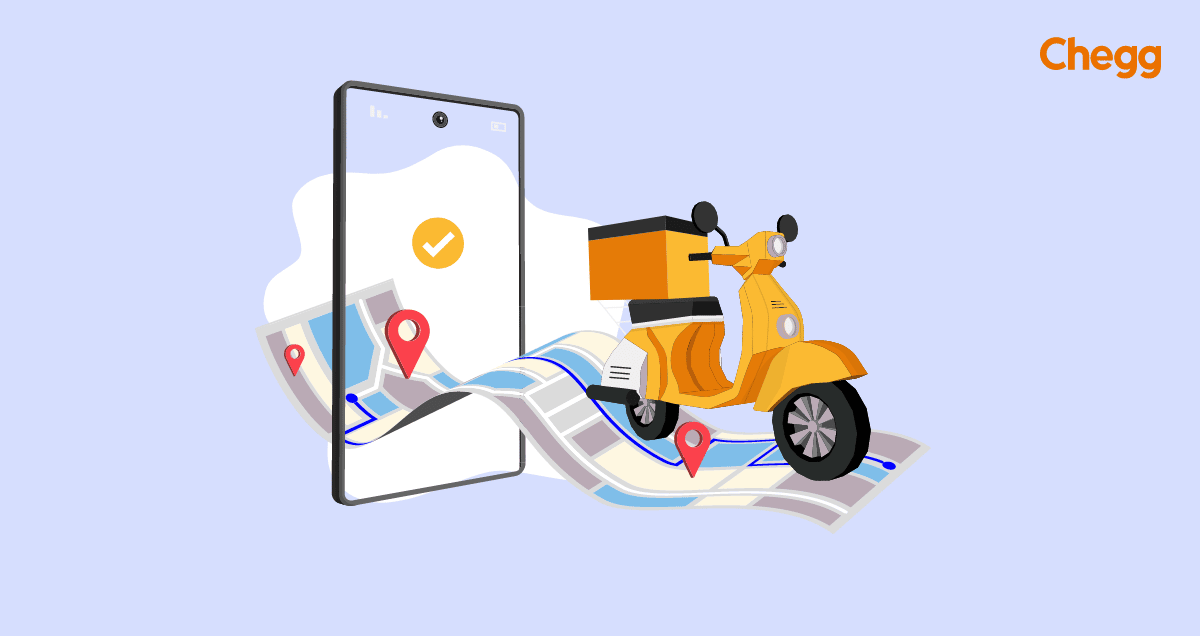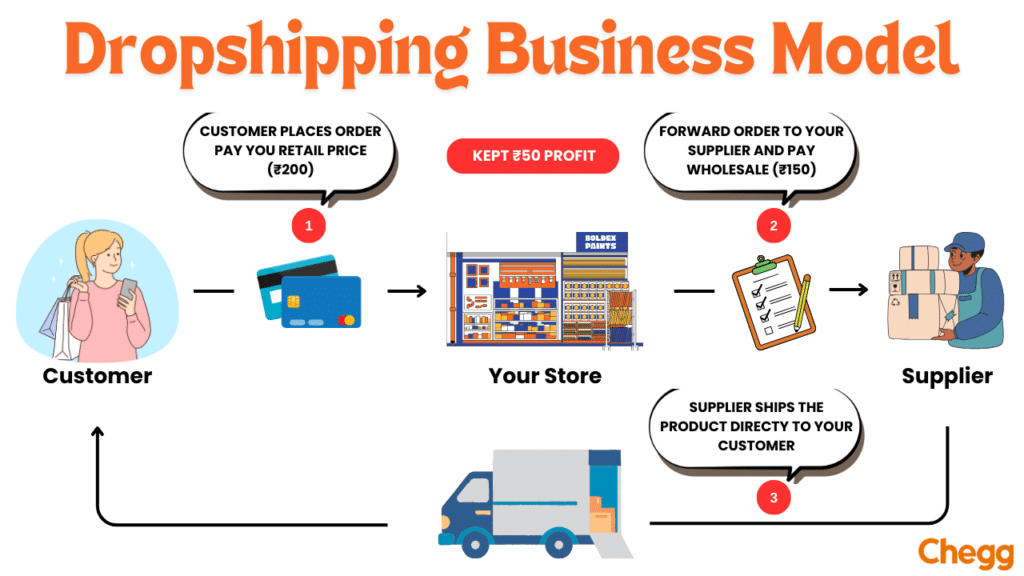

Quick Summary
Setting up a dropshipping business in India has emerged as one of the most lucrative and low-risk e-commerce models. Trusted suppliers handle delivery directly to your customers. With the rapid rise of e-commerce in India, digital payment adoption, and improved logistics in 2025, dropshipping offers a scalable and low-risk way to start an online business, perfect for aspiring entrepreneurs, students, and side hustlers.

Dropshipping is a retail fulfillment method where you, as a seller, don’t keep products in stock. Instead, when a customer places an order on your online store, you purchase the product from a third-party supplier who ships it directly to the customer.
Dropshipping in India allows you to sell products without worrying about inventory management or shipping logistics. You act as the middleman between the customer and the supplier, earning a profit margin on each sale.
Dropshipping in India is particularly appealing because of the growing e-commerce market and increasing internet penetration. It’s a great way to test different products and niches without significant financial risk.
Dropshipping in India has emerged as one of the most lucrative and low-risk e-commerce models, especially with the rise in digital payments, logistics infrastructure, and consumer trust in online shopping. Here’s a detailed, step-by-step guide on how to start dropshipping in India, optimized with long-tail keywords to help you scale a profitable business.
The first step to starting your dropshipping business is selecting a high-demand, low-competition niche. A niche refers to a specific category of products targeted to a defined audience.
Tips for Choosing a Profitable Niche:
Once your niche is finalized, the next step is finding trustworthy dropshipping suppliers India can rely on for timely delivery, consistent product quality, and easy return support.
Top Supplier Platforms for Indian Dropshippers:
Pro Tip: Always request sample products and assess communication quality, packaging, and delivery speed before committing.
Creating your e-commerce store is essential to start selling products. Your store will be the face of your business.
Best Platforms for Dropshipping in India:
Must-Have Pages: Home, Shop, About Us, Contact Us, Return Policy, FAQs, and Privacy Policy.
SEO Tip: Use keywords like “affordable dropshipping in India,” “Indian dropshipping suppliers,” and “dropshipping suppliers India” throughout your product descriptions and blog content.
Even with great products, you won’t get sales without effective marketing. A proper digital marketing plan is crucial for attracting traffic and converting visitors.
Top Marketing Channels for Dropshipping Stores in India:
As orders begin to flow in, managing them smoothly is critical. Since you’re relying on third-party suppliers, automation and prompt communication are key.
Top Tools for Order Fulfillment and Inventory Management:
Customer Support Tips:
To build a long-term, scalable dropshipping business in India, monitor your performance regularly and make data-backed improvements.
Key Metrics to Track:
Tools to Use:
Dropshipping is a retail fulfillment method where the seller doesn’t keep the products they sell in stock. Instead, when a customer orders, the seller purchases the item from a third-party supplier or manufacturer, who then ships the product directly to the customer. Here’s how it typically works:

Dropshipping is popular because it requires less upfront investment and inventory management. However, it has challenges such as finding trustworthy suppliers, managing shipping delays, and handling customer service.

Choosing the right platform is critical for the success of your dropshipping business. Here are some of the best options available:
| Platform | Features |
|---|---|
| Shopify | Easy setup, good for beginners |
| WooCommerce | Customizable, requires WordPress |
| Amazon Dropshipping | Large customer base, higher competition |
| Flipkart Dropshipping | Trusted Indian marketplace |
Each platform caters to different needs, so choose one that aligns with your goals for dropshipping in India for beginners.
Most of these platforms integrate well with popular Indian payment gateways. Here are some options:
Choose a payment gateway that offers competitive rates and supports multiple payment methods (credit/debit cards, UPI, net banking, etc.).
When choosing a platform, consider:
Remember, the best platform for Drop shipping in India depends on your specific needs, technical expertise, and budget. Don’t hesitate to explore a few options before deciding!
Now that you know what dropshipping is. Let’s know the different types of dropshipping businesses you can choose from in India.
In B2C dropshipping, businesses sell products to everyday customers through online stores. Think of it like an online shop where you can buy clothes, gadgets, or health products.
In this model, one business sells products to another company, often in bulk. It’s like a wholesaler supplying goods to a retail store, helping companies to stock up without holding inventory themselves.
Print-on-demand lets you create custom-designed products, like T-shirts or mugs, that are only made when someone orders them. You don’t keep stock; every order is printed fresh for the buyer.
Niche dropshipping focuses on a specific type of product or customer group, like eco-friendly items or pet supplies. This helps you stand out and attract customers who are passionate about those particular products.
Global dropshipping involves selling products from international suppliers to customers in India or other countries. This allows you to access various products, often at lower prices.
In local dropshipping, businesses work with nearby suppliers to sell products within a specific region. This means faster shipping times and supporting local merchants and products.
Crowdfunding dropshipping uses platforms like Kickstarter to see if people want a product before you start selling. It helps you test ideas with potential customers and gather funds before production.
Subscription-based dropshipping allows customers to receive products regularly. It creates a steady income stream and helps keep customers coming back for more.

Despite these challenges, many people find that the benefits of dropshipping outweigh the drawbacks, especially when starting in e-commerce.
Recommended Read: Top 8 Online Reseller Business Ideas: Best Opportunities for 2025
The rise of e-commerce in India makes dropshipping in India a profitable venture, with access to global suppliers and a growing online market. Starting a dropshipping business in India is relatively low-cost compared to traditional retail businesses. Here’s a breakdown of the typical expenses you might incur:
You can start a dropshipping business in India with an initial investment of around ₹10,000 to ₹30,000, depending on the scale and tools you choose. It’s a flexible and scalable business model, making it an attractive option for aspiring entrepreneurs.
Before starting your business, it’s essential to understand the legal aspects of dropshipping in India. While no specific law governs drop shipping, you must comply with general business regulations.
Adhering to these legal requirements ensures your dropshipping business in India operates smoothly and avoids penalties.
When running a successful dropshipping business in India, choosing the right suppliers is one of your most important decisions. A reliable supplier ensures that your customers receive high-quality products on time, which keeps them happy and boosts your reputation. Here is the list of the best dropshipping suppliers in India:
When selecting suppliers for your dropshipping business in India, always prioritize a few key factors:
By partnering with reliable suppliers like those mentioned above, you can set a strong foundation for your dropshipping business and build a loyal customer base.
Dropshipping in India offers immense opportunities for aspiring entrepreneurs. With low startup costs, flexibility, and access to global markets, starting your own online business has never been easier. You can build a thriving dropshipping venture by following the steps outlined in this guide and staying committed to learning and improving.
Remember to focus on providing value to your customers, optimizing your content for search engines, and continuously analyzing your performance. Whether you’re just starting or scaling your existing business, dropshipping in India can transform your entrepreneurial dreams into reality.
With our Business Guide, discover Unique Business Ideas, build a successful business from scratch, and learn effective business growth strategies.
Yes, dropshipping is legal in India. However, you must comply with business registration, taxation (like GST), and consumer protection laws. Ensure you partner with reliable suppliers and avoid selling prohibited or counterfeit products.
The best dropshipper in India is Baapstore, known for its vast product range, reliable suppliers, and automated tools. Other top options include GlowRoad, Shop101, and TradeIndia, offering affordable, beginner-friendly dropshipping solutions for Indian entrepreneurs.
Yes, earning ₹1 lakh per month is achievable with the right strategy. Focus on trending products, effective marketing (SEO, ads, influencers), and excellent customer service. Building a strong brand and targeting the right audience are key to scaling your business.
Manjeet Singh Sangha, also known as Desirichkid, is a successful dropshipper in India.
Some of the best Indian dropshipping suppliers for Shopify include vFulfill, Printrove, Syncee, and Blinkstore. These suppliers offer a wide range of products and seamless integration with Shopify.
The initial investment for dropshipping India can be as low as ₹10,000 to ₹30,000, depending on the platform, product sourcing, and marketing expenses.
Starting a dropshipping business with no money is challenging but not impossible. You can use free eCommerce platforms, promote products via social media, and rely on organic traffic to drive sales. However, investing in marketing and a domain name can significantly enhance your chances of success.
Income from dropshipping in India varies depending on your niche, supplier reliability, marketing efforts, and order volume. On average, successful dropshippers can earn anywhere between ₹30,000 to ₹1,50,000 per month, with some scaling even higher through strategic optimization and product selection.
To start dropshipping, choose a niche, set up an online store using platforms like Shopify or WooCommerce, find reliable suppliers, list their products, and promote your store through digital marketing. When a customer places an order, your supplier ships the product directly to them.

Authored by, Samiksha Samra
Digital Content Writer
Samiksha is a writer with a passion for sharing ideas and a knack for detail. She loves turning concepts into meaningful, engaging content. With a strong background in research and content strategy, she crafts clear, easy-to-understand narratives that resonate with readers. Her curiosity drives her to explore new subjects, ensuring every piece she creates is both insightful and impactful.
Editor's Recommendations
Chegg India does not ask for money to offer any opportunity with the company. We request you to be vigilant before sharing your personal and financial information with any third party. Beware of fraudulent activities claiming affiliation with our company and promising monetary rewards or benefits. Chegg India shall not be responsible for any losses resulting from such activities.
Chegg India does not ask for money to offer any opportunity with the company. We request you to be vigilant before sharing your personal and financial information with any third party. Beware of fraudulent activities claiming affiliation with our company and promising monetary rewards or benefits. Chegg India shall not be responsible for any losses resulting from such activities.